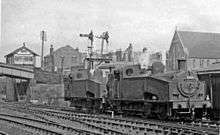GNR Class J23
|
J50/3 No. 68973 0-6-0T at Doncaster Locomotive Depot, fresh from repair at Doncaster Works | |||||||||||||||||||||
| |||||||||||||||||||||
| |||||||||||||||||||||
| |||||||||||||||||||||
| |||||||||||||||||||||
The Great Northern Railway Class J23 was a class of 0-6-0T steam locomotive. They had long side tanks that came to the front of the smokebox, which sloped forwards to improve visibility and had a recess cut in to aid maintenance. Forty were built by the Great Northern Railway (GNR) between 1913 and 1922, with a further 62 being added by the London and North Eastern Railway (LNER) between 1924 and 1939. There are plans to build a new J50/2 as of April 2013.
History
For shunting and local goods work, the Great Northern Railway (GNR) had traditionally used saddle-tank engines of the 0-6-0 wheel arrangement; the last of these, of GNR Class J13, having been built in 1909 to the designs of H.A. Ivatt, the GNR Locomotive Superintendent.[1][2]
Nigel Gresley succeeded Ivatt in 1911,[3] and soon identified a need for engines to work the short-haul coal traffic in the West Riding of Yorkshire; the nature of which required that the locomotives also be suitable for shunting. He designed a new class of 0-6-0 tank engine, using side tanks instead of saddle tanks.[4] Gresley had recently begun the rebuilding of the GNR Class L1 0-8-2T locomotives with larger boilers, 4 feet 8 inches (1.42 m) in diameter,[5] which left a number of 4-foot-2-inch (1.27 m) diameter boilers spare. Thirty of these were used in the construction of the new goods tank engines between 1913 and 1919;[4] when ten more were built in 1922, these again used secondhand boilers, but 4 feet 5 inches (1.35 m) in diameter.[6] On the GNR, both varieties were classified J23, but the LNER divided them into J51 with smaller boilers, and J50 with larger boilers.[4] The LNER continued the construction of Class J50, building a further 62 up to 1939,[7] only the first ten of which were given secondhand boilers.[8] Class J51 were rebuilt to class J50 between 1929 and 1935.[4]

Each of the two main classes exhibited variations: locomotive brakes could be operated by vacuum or steam pressure; the driving position could be on the right- or the left-hand side of the cab; and there were three sizes of coal bunker. These variations were recognised by class subdivisions:[7]
- J51/1 10 built 1913–14, 4 ft 2 in boiler, vacuum brake, right-hand drive, short bunker
- J51/2 20 built 1914–19, as J51/1 but long bunker
- J50/1 10 rebuilt 1929–35 from J51/1 with 4 ft 5 in boiler
- J50/2 20 built 1922–24, as J51/2 but 4 ft 5 in boiler, plus 20 rebuilt 1929–34 from J51/1 with 4 ft 5 in boiler
- J50/3 38 built 1926–30, 4 ft 5 in boiler, steam brake, left-hand drive, long bunker
- J50/4 14 built 1938–39, 4 ft 5 in boiler, vacuum brake, left-hand drive, long bunker with hopper
All were built at Doncaster, except the last fourteen which were built at Gorton.[9] Further orders were placed in 1939 and 1941 totalling 25 more locomotives, but these were cancelled in 1942 after a number of components had been manufactured.[10]
Numbering
On the GNR, the numbers were 157–164, 166–176, 178, 211–230; these were increased by 3000 by the LNER.[11] The first ten engines built by the LNER were numbered 3231–40, following on from the GNR engines;[12] but those built from 1926 were given scattered numbers between 583 and 636, between 1037 and 1086, and 2789–94.[13]
In 1943, new numbers were allotted in a continuous block from 8890 to 8991; these numbers were applied between January and December 1946,[14] but before this could be done, the oldest ten, nos. 3157–64/6/7 were temporarily renumbered 3180–9 in May and June 1945. They duly received their permanent numbers 8890–9 between June and December 1946.[15] Under British Railways, the 1946 numbers were increased by 60000.[16]
The J50 Group: Rebuild of 68905
As of April 2013, there are talks of new building a J50/2 numbered 68905, a recreation of a previous member of the class. A group of enthusiasts will stage a meeting to discuss about the plans, the build and the financial costs. One of the main issues is raising the funds for the project. As of November 2015, the building of 68905 has not commenced.
Notes
- ↑ Groves 1987, pp. 260–2.
- ↑ Allen et al. 1970, pp. 25–26.
- ↑ Groves 1992, p. 3.
- 1 2 3 4 Groves 1992, p. 65.
- ↑ Groves 1990, pp. 75–76.
- ↑ Groves 1992, p. 70.
- 1 2 Allen et al. 1970, p. 7.
- ↑ Groves 1992, pp. 71,72.
- ↑ Allen et al. 1970, pp. 8,11,12.
- ↑ Allen et al. 1970, p. 13.
- ↑ Allen et al. 1970, pp. 7,8,11.
- ↑ Allen et al. 1970, p. 11.
- ↑ Allen et al. 1970, p. 12.
- ↑ Allen et al. 1970, p. 8.
- ↑ Allen et al. 1970, p. 19.
- ↑ Allen et al. 1970, p. 16.
References
- Allen, D. W.; Boddy, M. G.; Brown, W. A.; Fry, E. V.; Hennigan, W.; Manners, F.; Neve, E.; Proud, P.; Roundthwaite, T. E.; Tee, D. F.; Yeadon, W. B. (November 1970). Fry, E. V., ed. Locomotives of the L.N.E.R., part 8A: Tank Engines - Classes J50 to J70. Kenilworth: RCTS. ISBN 0-901115-05-3.
- Groves, Norman (1987). Great Northern Locomotive History: Volume 2 1867-95 The Stirling Era. RCTS. ISBN 0-901115-62-2.
- Groves, Norman (1990). Great Northern Locomotive History: Volume 3a 1896-1911 The Ivatt Era. Lincoln: RCTS. ISBN 0-901115-69-X.
- Groves, Norman (1992). Great Northern Locomotive History: Volume 3b 1911-1922 The Gresley Era. Lincoln: RCTS. ISBN 0-901115-70-3.
External links
| Wikimedia Commons has media related to GNR Class J23 / LNER Class J50. |
- http://www.lner.info/locos/J/j50j51.shtml
- Railu database J50/1
- Railu database J50/2
- Railu database J50/3
